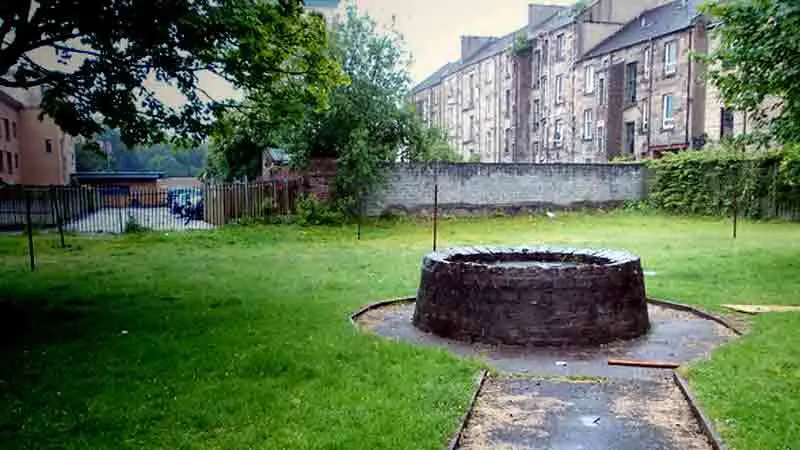Witches’ Memorials in Scotland

The Witchcraft Act 1563 resulted in approximately 4,000 innocent people being accused of witchcraft. Confessions were routinely obtained by torture and around 2,500 of those accused were convicted and executed, normally by way of strangulation and then burning at the stake. Scotland killed five times as many people as witches than elsewhere in Europe. 85% of those accused were women.
Many markers, stones and memorials across Scotland remember the local people who were sent to their brutal deaths prior to the repeal of the the Witchcraft Act in 1736.
1. Witches Well, Castle Esplanade, Edinburgh
A cast iron fountain honours the hundreds of innocent people burned at the esplanade for the crime of witchcraft. During the 16th century, more women were murdered at this site than anywhere else in Scotland.
More info



2. Gallow Green, Paisley
In 1696, 4 women, a man & 2 children were strangled and burned at this site after being found guilty of witchcraft. Another man hung himself in jail before the sentence could be carried out.
The well is all that remains today.
More info

3. Maxwellton Cross Memorial, Paisley
The ashes of all seven were buried at Maxwellton Cross which is now a busy intersection. The grave was marked with a horseshoe to keep the witches curse at bay.
More info
“Pain Inflicted, Suffering Endured, Injustice Done.”


4. Witches Stone, Bo’ness
In 1648 six women were burned as witches in Carriden, possibly at the spot where the Witches Stone still stands not far from the old graveyard at Carriden House.
More info

5. Witches Stone, Spott, East Lothian
It marks where Marion Lillie, the Rigwoodie Witch, was burnt about 1698 and serves to commemorate other ‘witches’ who were hunted in this district.
More info

6. Statue in Prestonpans, East Lothian
A memorial to the 81 alleged witches tortured and executed in Prestonpans. Their innocence was publicly declared in 2004.
More info

7. Culross Plaque, Fife
An estimated 380 people in Fife (mostly women) were accused of witchcraft. The plaque faces the Town Hall where 32 accused women were held.
More info
“Innocent victims of unenlightened times”

8. Valleyfield Wood Plaque, Fife
Dedicated to Lilias Adie 1640-1704 who died awaiting trial.
More info
“An ordinary woman accused of “lying with the devil””

9. Torryburn Plaque, Fife
The plaque overlooks the beach where Adie’s body was buried in the intertidal mudflats of Torryburn beach under a heavy sandstone slab to prevent the devil reanimating her.
More info


10. Witches Maze, Tullibole Castle, Crook of Devon
Maze of beech hedges with a pillar in the middle, etched with the names of the eleven victims of the witch trials in 1662.
More info


11. Maggie Wall Monument, Dunning, Perthshire
“Maggie Wall burnt here 1657 as a witch”. Yet mysteriously, there is no record of a woman named Maggie Wall being tried as a witch, and very little information on the monument either.
More info

12. Witches Stone, Monzie, Crieff
Kate McNieven is supposedly the witch who gave her name to the stone, although there are some doubts about when she was burned, or even her existence. She was rumoured to be a healer who sometimes turned into a bee.
More info

13. Grissel Jaffray Mosaic, Dundee
Both Jaffray and her husband were accused of witchcraft and may have been targeted for being Quakers. In 1669 Jaffray was strangled and burned at the stake. Her husband was set free.
More info

14. Forfar Witch Memorial
The memorial stone is simply dedicated to the “Forfar Witches”, and features 22 dots that represent each of the women who were killed for the “abominable cryme of witchcraft.”
More info
“Just people”

15. Gallus Quines & Deeds Not Words street art, Aberdeen
The witchcraft panic of 1597 lead to the execution of 30 people in Aberdeen. This mural is next to St Nicholas Church which was used as a prison for the accused witches.
More info

16. Witches Stone, Forres
The plaque reads: “From Cluny Hill, witches were rolled in stout barrels through which spikes were driven. Where the barrels stopped they were burned with their mangled contents. This stone marks the site of one such burning.”
More info


17. Witch Memorial Plaque, Kirkwall, Orkney
At least 19 women and one man, accused of worshipping the occult, went on trial in the county between 1594 and 1645, with nine of them sentenced to death by hanging or at the stake.
More info
“They wur cheust folk”


18. Witches Stone, Dornoch
Janet Horne was the last person to be executed legally and burned for witchcraft. Most likely suffering from dementia, Janet was stripped, tarred and burned alive. The date on the stone, 1722, is disputed and should probably be 1727.
More info

Although witchcraft has been legally abolished, the cult of the witch is so dear to humanity that it is, in some aspects, prevalent today as it was some centuries ago.
TJ Salmon, 1913
See also some photos of our meeting in March at the Witches’ Well, Edinburgh, and GussieGrips article in The Critic.
